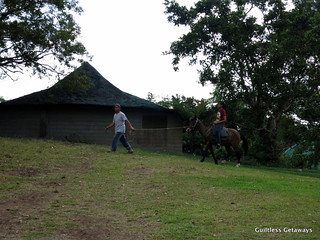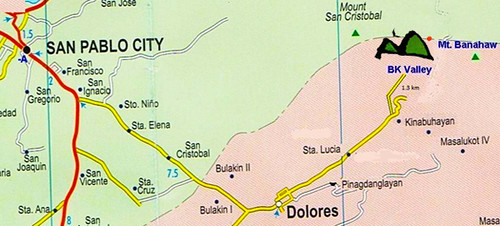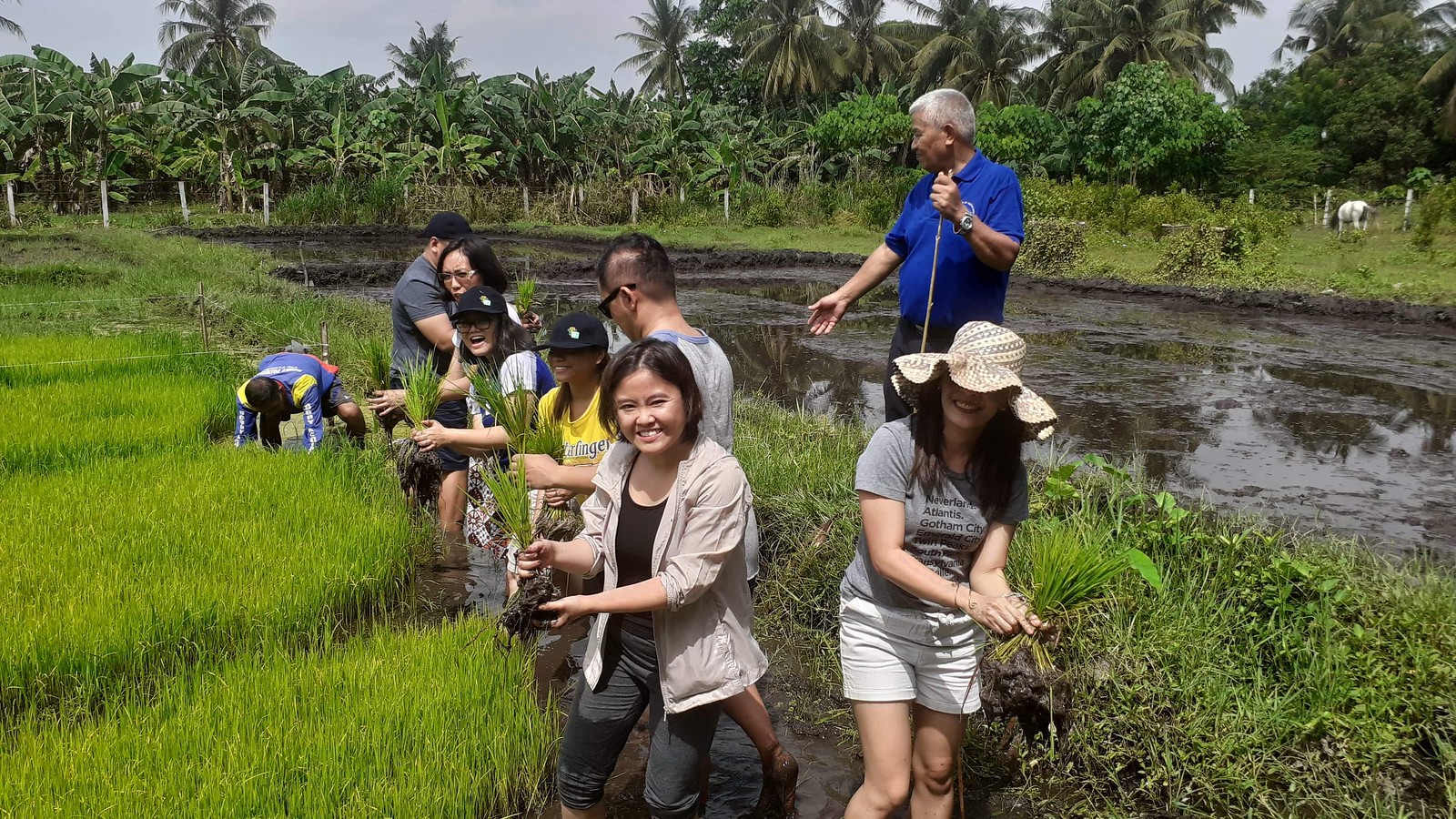I'm having an unbelievable streak this year of going to places (in the Philippines) that I've never been to and heard of before! Haha. Folks, this is about a protected area, an isolated valley, a retreat place and mountain lodge at the BK Valley in Barangay Kinabuhayan, Dolores, Quezon! As we are nearing Holy Week, would you want to consider an alternative to climbing Mt. Banahaw or Mt. Cristobal - like sitting on a wooden bench with the view of the holy mountains, getting close to nature and learning about the sustainable efforts of the community who live around it? Say hi to environmentalist Dionisio Pullan - a descendant of Agripino Lontok (known as the first hermit of Mt. Banahaw) who found his way back to the Bangkong Kahoy Valley and pushed for eco-tourism. Spend some time in this 21-hectare private property (also bird-watching haven) and don't forget to eat organic food (think raspberries and mushrooms...) to your heart's content! More importantly, this is a field study center and a big classroom - where we can immerse ourselves fully and learn about the land, the community, the environment, our ecosystem and the important role that certain species play.
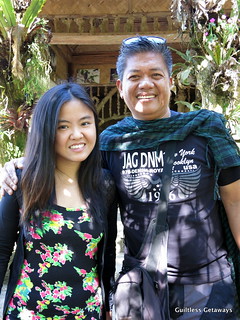
And no, this has no relation to my partner BK (just so happens that this was Boy Kuripot's first time to be introduced to natural and organic farming with me) lol. This BK stands for Bangkong Kahoy and you can find lots of freshly harvested oyster mushrooms and pick Philippine raspberries here :) The name "bangkong kahoy" came to be because of "the live tree trunks and branches shaped like a bench" that can be found around this area of Mount Banahaw.
Bangkong Kahoy is situated near (at the foot of) Mt. Banahaw and Mt. Cristobal - like Costales Nature Farms in Majayjay, Laguna (according to Sir Dion - 110 km south of Magallanes exit) :D
We just came from Puerto Galera (check out my Malasimbo Arts & Music Festival post) so we hopped on a bus from Batangas pier to Sto. Tomas and another bus to SM San Pablo then met the others there 1.5 hours later. 40 minutes via van from there, we arrived at our destination - the Bangkong Kahoy Valley Nature Retreat & Field Study Center.
A closer look at that one tree above: I saw these mushrooms and someone told me that it might be tainga/tenga ng daga (rat's ears, cloud ear fungus). I'm thinking these are more like Turkey Tail mushrooms ;) I should have known that this was just a preview of what's to come hehe.
When we arrived, there were groups of UP Los Banos students on field trips in this area. There's a red clay tennis court (supposed to be the first of its kind in the country) for guests.
We lounged around low wooden benches (bangkong kahoy) while we waited for our tour hehe. Ah, I missed sitting that close to the ground... Bangkos were a staple in our house when we were little. I wish I had the time in the world to just sit, keep myself still, stare at nature's wonders before me and reflect on the turn of events in my life... On another level, I was looking forward to being close to nature and close to the ground again with this ATI-DAR (Agricultural Training Institute of the Philippine Department of Agriculture) trip... =)
As usual, we got to experience the food that this valley is able to provide first. They were serving produce from the organic farm for lunch.
My first peek and taste involved mushrooms. The hot corn soup was tasty and I bit into generous chunks of shrooms.
This was starched taro puffs. It will grow on you as you eat more with just the right amount of crunchy, subtle flavor and soft center. :)
The star of the meal was the dessert - fresh raspberries (from the BK Valley farm) sprinkled with sugar to counter the bitter-sour taste. I'll tell you more about this in the next post!
A little after noon, we went to check our rooms for the night and to freshen up since the we all had a long morning (well I hadn't slept yet and the sun was blazing)!
The BK Mountain Lodge is just 3-5 minutes away from the dining area. It's the sister resort of Eagle Point Resort in Anilao, Batangas.
We were divided into gals and guys at 4-5 occupants per room. There are only 4 rooms at the BK Mountain Lodge at P6000 a night per room but there are other options like camping (P50 per person + P50 entrance fee) and other more native accommodation options here.
I was ready to crash and a nap was in order!!! Hahaha. The beds (queens) were so much bigger than you would initially think with the picture below. The room size was at 50 square meters. One thing I really liked (and haven't seen much in the Philippines before) were the velvety plush throw blankets. They're thin but very effective for the cold night weather in this location. I'm guessing that since Mr. Pullan lived abroad for a while - that the linens might be imported.
With the added floor space and pullout beds, it could easily fit 6-7 people! We had a fireplace, cable TV, mirror,
fan (no need for aircon, so cold naturally at night!) and cabinet space (there's a small safety box and fridge in there).
The toilet was decent (there was constant water noise though it can be drowned out by closing the CR door, think our room was near the pipes or the tank).
There was hot water with a rainshower head.
We met Mr. Dion Pullan shortly after we settled down. He calls himself the "caretaker" (rather than owner) of the Bangkong Valley Nature Retreat & Field Study Center. His ancestors has been living in this area for decades and he grew up here before he lived in Australia for more than 20 years. He came back and helped convert the Bangkong Kahoy Valley community into an organic farming site - aiming to keep their home (and water table Mt. Banahaw) pesticide-free and chemical-free, as well as providing alternative livelihood opportunities for neighboring barangays.
He told us that since the BK Valley was titled in the 1920s, it was included when Banahaw was declared as a national park and protected area (now known as the Mount Banahaw-San Cristobal Protected Landscape) in the 1940s. He also admitted to having a difficult childhood here where he'd just walk for hours just to get to and from school to get a decent education. Today with his vision, the young members of the BK Valley community group spend their free days at the farm learning about the organic farming, planting indigenous trees, improving their productivity and caring for the environment.
As we got off the ground and started our tour, I was immediately drawn to the open spaces. How I'd wish to just lie down there for a while, find a shady-enough tree, close my eyes and hear the birds chirp haha.
The clean rooms and sanitation areas for mushrooms we went to piqued my interest (because we weren't allowed to go in obviously haha). Sir Dion said they are UV-treated so you can't go out until you finished what you started with the mushrooms because they might risk contamination... I love mushrooms and I used to just assume that all of them were wild (with the truffle hunting episodes on TV and all haha)... I was surprised that the mushrooms produced at the BK Valley were cultured (thus the need for labs and sanitary areas).
My mind was still racing with CSI-like cultures, lab gowns, DNAs, petri dishes and genetic mutations when we were stepped into a fruiting bag packing area. There's no mushroom tissue here yet and I guess they will disinfect the bags after so we could watch them without gear and all.
They sell the fruiting bags for P40 each with an assurance of harvesting 300 grams per 100 days. I don't think this is the final product they sell yet.
If I got the mushroom production process right, a clean tissue is removed from the fruitbody of a good oyster mushroom using sterilized processes and tools. The sterile tissue culture is put in a medium to grow the fungi. In a few days or week, the mycelium should start to grow. The mycelium (white stuff) is transferred/inoculated to the grains to increase culture size. The barrels below must be the ones they use to pasteurize the bags. I'm sorry I'm not such an oyster mushroom expert.. hehe. The folks at the BK Valley Farm though have mastered and developed their own process applicable to the Philippine setting after a lot of trial and error =) They're really having success with their goal to make mushrooms affordable and available locally.
If the fruiting bags are "rejects" (if they probably didn't grow mycelium...), they are used for compost in the farm since the mix is already rich in nitrogen.
And if you still think growing mushrooms are easy and you just plan on buying them in ready-made fruiting bags, a.k.a. oyster mushroom kit in a bazaar somewhere in the metro (I've seen one!), then you're mistaken. Hehe.
The right temperature, water and light conditions are just some of the basic things you need to look out for. You'll just be skipping the lab gown and culturing and pasteurising steps hehe. The bags shouldn't be put in direct sunlight. They need water and if you do it manually, then according to Sir Dion here they "mist" (not spray!) it one by one carefully and manually 2 times a day. In lowlands, the recommended "misting" is every 2 hours!
Sir Dion said that 90% of a mushroom is water so when mushrooms are dried, it can go for up to P2000 per kilo and it doesn't get bad (di raw nasisira).
Fancy growing your own mushrooms yet? Oyster mushrooms (scientific name: Pleurotus Ostreatus) at the BK Valley goes for P160 to P200 a kilo. So a fruiting bag can produce 300 grams - plus or minus 4 successful fruiting bags x P40... Not bad! Haha.
There's risk of spores, bacteria and contamination if you're a beginner at this. I guess if you see the colors of the rainbow appearing then those are molds already ;) Sir Dion mentioned that his mushrooms are special - they have a darker cap and white gills.
Seeing growing mushrooms indoor seemed to be as fun as finding wild mushrooms for me during this trip hehe. Just look at those babies... It takes TLC , research and trial & error to grow them and all plants!
Mushrooms are a great source of fiber and anti-oxidants ;) Watch out for other oyster mushroom and organic gulay dishes on the next post!
Other activities in the Bangkong Kahoy farm include horseback riding, trekking, mountain biking, camping and many more.
Buy something here to support the community before you leave =D I just noticed that the floor to the chapels were mushrooms-shaped! Haha. Check out my next post for Philippine raspberry-picking at Bangkong Kahoy!
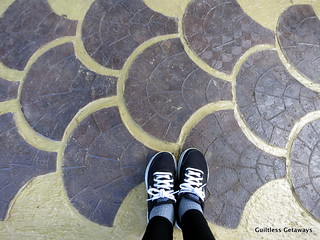
Farm Details:
Bangkong Kahoy BK Valley Nature Retreat & Field Study Center in Dolores, Quezon near Mt. Banahaw-Cristobal
Mr. Dionisio "Dion" Pullan and Ms. Jing Pullan
Bangkong Kahoy BK Valley Nature Retreat & Field Study Center in Dolores, Quezon near Mt. Banahaw-Cristobal
Mr. Dionisio "Dion" Pullan and Ms. Jing Pullan
Sitio Bangkong Kahoy, Brgy. Kinabuhayan,
Dolores, Quezon Province 4326
How to Go to Bangkong Kahoy Valley Resort Nature Retreat & Field Study Center Directions:
By car -
From SLEX, taking on the new link tollway to STAR Toll way. Do not enter STAR Toll way but exit to Sto. Tomas. Take the National Highway heading towards Alaminos, San Pablo City & Lucena City. Take the by-pass road which curves right after SM San Pablo. After passing the San Pablo Meralco office, take a left turn towards Dolores. From Dolores, go to Brgy. Kinabuhayan. Turn left before entering Kinabuhayan proper and go up the mountain (about 2 km.) to the BK Valley Resort. - Source
By commute -
Take Manila to Lucena bus. Get off at 7-11 San Pablo (near public market). Take a jeepney bound for Kinabuhayan and get off at junction foing to Bangkong Kahoy. Either trek 2 km. up or arrange for pickup via their hummer for a fee. - Source
To visit the different ATI-assisted projects (Organic Farming Learning Sites), you can drop by or ask the ATI Regional Training Center nearest you or inquire through:
Call -
982AGRI (982-2474) for Metro Manila calls
1-800-10-982AGRI (1-800-10-9822474) for provincial toll-free calls using PLDT landlines
Text -
For Smart and Talk & Text Subscribers, send a message to 391-DA (391-32).
For non-Smart Subscribers, send a message to 0920-946AGRI (0920-9462474).
